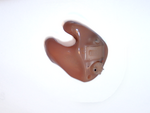
03 Jul 5 Types of Hearing Aids Explained: How Do They Work?
This article is for informational purposes only and is not a substitute for professional medical advice, diagnosis or treatment. Contact a qualified medical professional before engaging in any physical activity, or making any changes to your diet, medication or lifestyle.
Hearing loss can tremendously impact an individual’s quality of life, making it difficult for them to communicate with others and engage in their daily activities. While that is the case, modern technological advancements have been instrumental in the creation of hearing aids to enable those with hearing problems to communicate and engage with their surroundings. Professionals such as St. Louis hearing aids audiologists are responsible for providing people with the best solution for their hearing loss by determining the right devices for their patients. This blog post will look at five types of hearing aids professionals may recommend.
- In-the-ear (ITE)
 These devices are usually designed to fit your ear in two different ways – either a portion of the ear’s bowl (the half shell) or the whole ear (the full shell). In-the-ear devices are ideal for individuals with dexterity issues or people who find it difficult to handle small items. Furthermore, these hearing gadgets are designed for those with moderate as well as severe hearing loss.
These devices are usually designed to fit your ear in two different ways – either a portion of the ear’s bowl (the half shell) or the whole ear (the full shell). In-the-ear devices are ideal for individuals with dexterity issues or people who find it difficult to handle small items. Furthermore, these hearing gadgets are designed for those with moderate as well as severe hearing loss.
- Behind-the-ear (BTE)
These devices are ideal for those with a broad range of hearing loss. Specifically, behind-the-ear is suitable for people with mild as well as profound cases of hearing loss. The body of the gadget attaches to thin tubing or a custom ear mold. Because BTE consists of various parts, manual dexterity is crucial for ensuring the right insertion.
- In-the-canal (ITC)
Just like the name suggests, these hearing aids fit deeply in your ear’s canal compared to the ITE gadgets. For that reason, ITC hearing aids are barely visible. Since they are small in size, these devices utilize smaller batteries and can sometimes be difficult for someone to handle. In other cases, completely-in-the-canal may be used depending on one’s hearing situation. These gadgets are inserted deeper into the canal and are even less visible than the ITC devices.
- Receiver-in-the-ear (RITE)
These hearing aids have similar features as the BTE devices. The body sits right behind the ear. A receiver wire from the gadget goes over the outer ear into the canal. The tip sits right above the canal without covering it. This process is believed to offer a more natural sound. These gadgets utilize manual dexterity and are used in cases of mild to severe hearing loss.
- CROS/BiCROS
These hearing aids are recommended for people with minimal hearing loss in a single ear and a loss of hearing in the other ear. It is worn on the ear with better hearing and a microphone is worn on the side that has a hearing problem. This allows the wearer to hear from the side with the hearing problem despite the sound being delivered to the better ear.
Wrap Up
When you are suffering from hearing loss, you should seek professional help to get the right hearing devices for your case. Consulting with a professional audiologist, like those at Alexander Audiology, is important because it gives you an opportunity to receive the right diagnosis, hence the right intervention for your hearing loss. The professional may recommend a hearing aid from the many options available, tailored to your specific needs.
The information on MedicalResearch.com is provided for educational purposes only, and is in no way intended to diagnose, cure, or treat any medical or other condition. Always seek the advice of your physician or other qualified health and ask your doctor any questions you may have regarding a medical condition. In addition to all other limitations and disclaimers in this agreement, service provider and its third party providers disclaim any liability or loss in connection with the content provided on this website.
Last Updated on June 18, 2024 by Marie Benz MD FAAD
